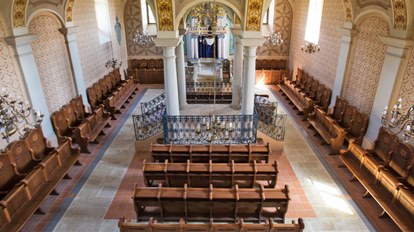Pilgrimage - The “ Wonder Rabbis' Way ”
Hungary, especially
Gepoilt ales gits!" is the Yiddish greeting everywhere at the jahrzeit of the Sátoraljaújhely Wonder Rabbis, or death anniversary of his death in the local Jewish cemetery.
However, it is not compulsory to visit the tomb only on the anniversary day; pilgrims come to Bodrogkeresztúr and Sátoraljaújhely, as well as to other cemeteries in the area, in large and small numbers throughout the year.
During our excursion we will learn about Jewish traditions, teachings, customs and the life of the wonder rabbis.
Route from Budapest or Debrecen/Hajduszoboszló :
Tarcal – Mád – Bodrogkeresztúr – Sárospatak – Sátoraljaújhely
Tarcal
Jewish families trading wine and grapes lived in Tarcal after their arrival from Poland in the middle of the 18th century. Their Baroque synagogue was probably build between 1790 and 1810 in Louis XVI style (86. Fő utca). The building itself is private property. Now called Gallery of Tarcal, it is being used as a venue for temporary exhibitions. The Jewish cemetery of Tarcal is located at 25. Keresztúri út. Among the hundreds of tombs rests Jakab Spira, the town's famous rabbi.
Mád
Mád was one of the religious centres
But the World War swept away the Jewish community of Mád. Barely forty returned from the hell of war, and they too tried in vain to rebuild their community. By 1956 the Jewish community of Mád had ceased to exist.
It is said that the Mád synagogue is one of the most
beautiful synagogues of the world and it is with good reason that it was
included in an album published in the USA, titled «100 Most Beautiful
Synagogues of the World». The excellent restauration work that was carried out
on the synagogue was recognized with the Europa Nostra Award. The largest
Jewish cemetery
Bodrogkeresztúr
Surrounded by beautiful scenery, the riverside village is an important site of Jewish pilgrimage routes. Reb Steiner Saje, wonder rabbi of the local Jewish congregation is known far and wide.
Legends tell of the miracles performed by the renowned
The former residence of the wonder rabbi was turned into a memorial house (65. Kossuth utca) and is now a popular pilgrimage destination along with his grave in the Jewish cemetery on the slopes of Dereszla hill.
Sárospatak
Sárospatak is a town in northern Hungary, situated along the
Bodrog River, at the junction
The Jewish community played a major role in the economic life of Sárospatak, a town with rich traditions at its core. The first Jewish residents settled in the town at the end of the 18th century. By the end of the 19th century, the community had its own school, a yeshiva, which was functioning until the end of World War II. There is a Holocaust memorial plaque on the community's old bath house, while the synagogue on Rákóczi út was converted to a shop. The Jewish cemetery is located on Arany János utca.
Sátoraljaújhely
Sátoraljaújhely is the most famous pilgrimage destination
price of shuttle and guide :
up to 3 person 830,−€/tour
up to 6 person 1065,−€/tour
up to 17 person 1310,−€/tour
up to 48 person 1715,−€/tour
the price does not include entrance fees during the programme.
